 |
| Photos on the way to Rabanal. We were just getting started. Caroline Shepard |
Sometimes a day on the Camino can feel like a week. Each blog only represents a day or two because so much happened, sometimes just between breakfast and lunch time, so many thoughts, feelings, emotions, reflections, and most of all footsteps. I do not really feel like we even started the Camino until the second week as we walked from Leon to Rabanal. Even though we had walked for two weeks at that point, we were just getting started.
Day 10
We left Burgos in good spirits, caught a bus
through the Meseta to Leon, skipping 180 k of the dessert. One can’t make every climb on such a trip.
 |
| Images of the dessert we were not walking through. I have wondered through the desert in Texas and California and its enough for me. |
We were glad to just step into Leon.
After dropping off our
stuff, we wandered for a nearby restaurant, La Cucina del Cathedral, for a
lovely dinner /late lunch. Number two
asked for lobster paella and I ordered sangria as we reveled in the nuances of
this city once occupied by the Romans, Visigoths, and Muslim invaders. The elder waiter friendly, sharing the ingredients
when I told him this was the best sangria I’d had in Europe.
“The secret is a little triple sec and fanta” noted
the genial waiter, listing what made up the concoction. “Zucca, vino tinto,
limone, anarancha fanta, quantro, un pica gin. Without gin, its ok for kids.”
The kids laughed.
After lunch we wandered through the Cathedral. It was every bit worth our efforts. A Gothic Cathedral, it is a marvel. Construction began in 1205 and completed by the end of the century, in less than a century. Its style consistent throughout, its stained glass illuminating and reflecting light from the setting sun.
There we ran into our friends from Chicago, who’d just finished walking the Meseta. They had 15 minutes to see the whole cathedral so they were in a rush. We were taking a more leisurely pace. The whole cathedral had just about collapsed at one point, but engineers saved it. And we were glad it was still there.
There we ran into our friends from Chicago, who’d just finished walking the Meseta. They had 15 minutes to see the whole cathedral so they were in a rush. We were taking a more leisurely pace. The whole cathedral had just about collapsed at one point, but engineers saved it. And we were glad it was still there.
 |
| My favorite cathedral on the whole trip in Leon. |
Out we wandered to see the Antonio Gaudi’s Modernist
Casa de Botines, just down the street, taking in the streets and people of this
gem of a city. We got our passports stamped over ice cream at Holy Cow and made
our way back to the room for an early bedtime.
Day 11 Leon to Villar
de Mozarife
Caroline was in the
mood for walking as we were leaving Leon. Just
as we made our way out, we stumbled into the Chicago family again, joining them
for a cheerful stroll out, following the faithful arrows. The father and I talked about his days in
Poland in the 1980’s when the Solidarity movement was just beginning. v The surveillance and repression stifled everyone. He had a friend who was picked up walking
home just before curfew and suffered in unspeakable evening. And
gradually Lech Welena started organizing meetings, gaining the support of some
90% of the population. The whole country joined the movement. Theres a lot of history to contemplate as we walk.
After the revolution,
the father left Poland and started life in the US. Over this trip, he has
enjoyed showing his kids his Europe, full of adventures and history. Today, his daughter is as comfortable in Madrid
as Chicago. She tells us about her
favorite topas restaurant, El Tigre.
“You have to go to
Topas Topas,” noted number one and two, telling her about their favorite spot
in Madrid, where they enjoyed churros con chocolate in the morning and ice
cream at night.
She says the landscape
along the walk reminds her of Utah, full of lush dessert.
Graffiti lined the
streets along the outskirts of Leon. The
guidebook suggested we skip this, but I found the decaying peripheries magical. After some ten k, we stopped at a street side
café and parted ways.
We would cross a
footbridge at a former pilgrim hospital and make our way into the country for
our days stroll. It would be another
twenty k before we arrived that night.
More and more people
chatted with us as we walked. It seems,
the youth have little interest in nationalism or borders. Everyone seems more interested in walking
together. At least they do on the way. Could the mutual aid of such connections open
up something for the world? Could this
be the future, us all wandering together? On the outskirts, we took the longer rural path, the Chicago family kept walking straight ahead.
 |
| This dog on a surfboard was a source of unending laughs for all of us. |
The road was full of
colorful details along the natural path. Everyone in their own thoughts, thinking of the light pouring through
the stained glass in the Cathedral, the purity of the sound, and smell of
incense. The walk starts to feel like a
dream.
Time passes and we dream Shakespeare wrote in Midsummer Night’s Dream. Hippolyta answers Theseus suggesting:
Four
days will quickly steep themselves in night;
Four
nights will quickly dream away the time;
And
then the moon, like to a silver bow
Now
bent in heaven, shall behold the night
Of
our solemnities.
Time would take on a
strange dimension on the Camino, passing quickly and horribly slowly on some of
the afternoon strolls.
Crossing hundreds of K
by foot is anything but a quick process.
Time and space overlap in intimate ways here. We pass more
time, crossing more k
per day. Walking less, means time passes
slower in the afternoons. But it all
passes through our minds and dreams.
We dream hard on the Camino,
working through all the aesthetic landscapes we are taking in on the long days,
between desserts, mountains, highways, towns, sunrise and set every day.
Caroline and I talked
about the idea of sustainable urbanism as we walked. Looking at cyclists who
cover the road with their human powered machines and humans doing what we have
always done, walk through distances.
“We are made to do
this,” notes one pilgrim.
Throughout the hike, we
carry what we really need and not much more.
Many comment on my bag with banjo and books. Others carry little but a
change of clothing.
We consume less as we
walk through time, away from the hyper consumption of capitalism. We walk
alternate route through the dessert where we dream, walking through the days,
looking out at the dessert bushes, vistas, at what life is, wondering what our
life will be. Maybe there is another
route instead of killing each other off, I wonder.
Here, we live with what
we have and are happy to have it.
I dream of Cervantez
and Marquez and the lush savannah.
“Look at the clouds,” I
note to number two who declares, “I’m in my own thoughts Dad.”
The thirty k walk is a
long one.
By one pm, we sat for a
long lunch of sardine sandwiches and rested our feet. Not quite time for beer. But we could have
easily stopped in the nowhere town.
But making our way
forward was hard. I walked ahead and
grabbed a few more sodas and peaches and started walking ahead. The mood of the family was not always
easy. So walking was sometimes the best
strategy for me. Sometimes walking is
all we could do. There would be less room for discussions. We just had to walk, hopefully in the right
direction.
“Camino?” I asked another hiker behind us. There was not an arrow in sight.
“You got it,” the lone
hiker replied, with a pause. “Where are
you from?” he asked.
“Brooklyn, USA.”
“I love New York,” he
replied and came to join us. He
explained, “I studied the architecture of the city. But I am nervous about the city. I’m scared I’m going to get to Times Square
and not know what kind or coffee to order.”
His name was Paul. And we’d walk with him for the next ten k to
the Casa De Jesus, where we’d all stay that night.
Number two walked with
us as Paul recalled his journey through the Northern route of the way up from
Irun through Bilbao.
“It was hard walking
along this route,” he confessed. “Lots of up hill hikes, mountains and then
beaches.”
“That’s where I want to
go,” I confessed.
“Walking you think about
where you want to go and where you’ve been. You hatch plans and you just walk,”
Paul advises number two, who is walking with us.
Number two recalls the
difficulties of Shackelton’s voyage and
struggles with survival in Antarctica.
“What happened in the
war? Who won?” he asked when he finally
found help after two years lost in 1916.
“The world has gone
crazy,” he was told. The war was still
raging, without an end in site.
Caroline walked behind
listening to her podcaste of hardcore history.
We strolled forward comparing what our walk with Shackelton’s
journey. Never simple at all, but ours
wasn’t that bad in comparison. Still, by
the last two or three k, we didn’t say much at all, just walking, hoping Casa
de Jesus would come soon. And it finally did.
Everyone took part in the pilgrim meal. An Irishman joined us, sitting with us as we talked
about our adventures.
He was making a book of
his pilgrim adventures for his kids, who he missed dearly, for their own
journeys. He recalled the night before
in Leon, when he went off the water wagon, drinking Guiness and whisky all
night.
Paul told us more about
his adventures on the North route of the Camino. “Definitely go to Astoria along the North
Coast of Spain,” he advised. “There is an inn called the Poo Albergue 300
meters from the beach.”
Everyone has a peak
moment of the Camino. With people
swimming on the coast in states of undress, this was his.
We talked and talked,
did laundry, hung out, and watched the sun go down. Paul was sitting looking with his sore leg
propped up, drinking a beer. We’d had a long day.
Day 12 – July 20th Villar de Mozarife to Astorga, Gaudi, and more
Giants
“Don’t get lost in the flower patches,” number two
said on our way out to Astorga. It was a beautiful sunny day.
The journey through the country to Astorga was our
longest walk yet, some 31 k. Yet, we all
walked together, making it in great time after leaving first thing in the
morning from Villava de Mozarife.
Everyone had said don’t go to Astorga. Bad things happen in Astorga. People get robbed in Astorga. There are
gypsies there. But we came anyways. And
I didn’t see anything dangerous.
Caroline and I talked about the long walk along the
way in comparison to other long walks and marches. The Chinese Revolution’s long walk, the walks
through deprivation in WWII in A town called Alice, walking and walking the
women in World War II, the Armenian Genocide, the Turks walking the Armenians
to death. We think of them as we walk.
Every night, we are exhausted, but there is shelter. There are big meals and places to bathe. They had none of this. We all had tired bodies, but none of the
rest.
We walk past the old Gothic Bridge at Hospital de Orbigo, site of a fabled medieval jousting competition, started walking with two American women from Colorado, one a nurse and another a social worker. It extends out into the countryside.
We walk past the old Gothic Bridge at Hospital de Orbigo, site of a fabled medieval jousting competition, started walking with two American women from Colorado, one a nurse and another a social worker. It extends out into the countryside.
“It’s the longest I’ve gone outside the country,”
explained one. We walked and talked
about social work and public health.
A German cyclist joined us. He was riding the whole
route and then riding back and then walking it every day. Walking with a group of nuns, he has been
meditating with them, while practicing as a hospice nurse. “The Camino is a
journey in between life and death the journey in between,” he muses, sounding
poetic as we all walk. I love the poets
of the road and there are many of them, channeling Homer and the Beats. Over
the coming weeks, I find myself thinking of St James, for whom Camino is
named. I am increasingly resentful of
the anti-choice, anti-hiv prevention positions which are the church’s positions
in cannon law, but I am also moved by the stories of James, who was said to be
with Jesus at the scene of the transfiguration and his weeping at the Garden of
Gethsemane. We all suffer. And sometimes we see something larger. This
is part of the story of this walk.
And sometimes strangers welcome us.
Walking through the dessert, we stumble into a man
offering free orange juice, fruits, coffee, water, etc. He is standing in front
of a large relic, no ceiling, but walls, with plants growing through them. He has organized a whole scene. Some people play guitars. A group of Korean actors are giving free
massages to everyone. One is known as a famous actor at home, but he got sick
with throat cancer. So now he walks. We stay for like two hours, playing music
and chatting, taking pictures, listening, taking in the vibe as pilgrims hang out, get
massages, and move forward, taking in the abundance.
An old man welcomed us just outside of the town,
asking to take pictures, praying with us, and applauding the whole family for
making it this far together. He greets
each child, says hello to other pilgrims, and lets us know he thinks what we
are doing is pretty special.
Astorga was full of surprises, but none of the usual
opponents, bed bugs would grip us, just the ups and downs of the Camino, mood
swings and giants.
Arriving number two and I washed all of our clothes and hung them out to dry. We had avoided blisters all trip and the dry sock and liner combination had worked so far. But we still needed to wash our clothes.
Everyone stayed home
for a nap and I wandered through the town. Signs for the American who had disappeared on
the Camino earlier in the summer were everywhere.
The Irishman we’d had dinner with the night before was there, hanging out. I greeted him and kept walking, not in the mood for pilgrims today. The Cathedral and the Gaudi loomed over the town.
The Irishman we’d had dinner with the night before was there, hanging out. I greeted him and kept walking, not in the mood for pilgrims today. The Cathedral and the Gaudi loomed over the town.
Hoping to match our Burgos culinary experience, I
searched for restaurants on trip advisor.
But they were all closed. So I walked into the Restaurant El Salvador,
where they offered a menu del dia off a side road.
Just closed restaurants, the Cathedral, and the
outside of the majestic Palacio de
Gaudi. Delirious with angles stretching into the sky, it was everything
one could imagine from the old master. Just seeing it in the sunset the outside
was enough. So we wandered, looked at jewelry, talked and made our way to bed.
We ended up staying up later than we wanted and then
could not sleep. Sometimes desire and
loneliness are part of the road, part of that feeling of being part everything
and nothing, with everyone and completely alone.
Day 13
Waking was even harder. Number one and Caroline were up and ready to
go. Number two and I were asleep and
grumpy.
“You didn’t dry my socks,” screamed Number Two at
6:30 am. “I do not want to get a
blisters.”
“Don’t yell at me.”
“Don’t yell at her.”
“Why are you yelling at me?”
So we grumbled our way to breakfast.
The man ahead of us complained that there was gluten
in the toast at desayano.
No eggs for Caroline. No Churros for the girls. Number
one was quiet. But the dark cloud was
everywhere. We would walk most of the day
to push through the dark cloud, battling giants and
demons as we stepped forward. There is a
lot of anger on the Camino.
It seeps up and grabs you, taking a hold for hours
and hours.
And so the grumbling continued. Wherever one travels, there one is. We cannot
leave ourselves behind.
We just cannot. So we walked and walk and walked
along our way to Rabanal, some 22k forward. At home, we do jujitsu and
yoga. Here we walk.
But the conflicts inside sometimes scream at the
sky, making their way to the outside world.
As we walk, the countryside takes on a more Celtic character,
as we start to enter the hills of Galicia.
15
k into the walk, we find ourselves in a small cowboy town of El Ganso, where a
man stands selling beautiful necklaces and playing a banjo, outside the Meson
Cowboy, a Tex Mex bar where we enjoy tamales and fantas. I show him my banjo. And he took a photo of it. The place felt like a mysterious sight from
one of the old cowboy wild westerns, like a ghost town. But it lifted the
mood. Something about the banjo music
loosened the grip of the mid day demon.
Battling giants is always easier with a banjo Pete Seeger explained in
Abayoyo. The town of El Ganso was the
site of a 13th century monastery. But little remains of it. By the
time we left, we were feeling a slight lift in our step again. It started to rain, cleansing us all.
By
the time, we get to Rabanal that afternoon, everyone was exhausted. And we take
the first albergue we can find. La Senda
has promised us a room. But apparently,
they lost it, giving it away. So we are
offered a space in sweaty living room full of college kids, the bunks pushed up
against each other. Everyone is sleeping
in the dark space. There is little room
for anything. Everyone settles in for a
nap and a large man dressed in little but a jock strap releases a large smelly
dose of gas into the room. Number two
gives mom a nod, “Happy family vacation,” she laughs.
Number
two has left her walking stick behind so I walk back to grab it, wondering what
we are going to do to lift the mood. The demons were grabbing us again. So I
walked and texted friends in the US. And I walked and found the cane sitting
against a log in a field where she’d left it.
I started back into town to look for something. The town was actually quite beautiful. The donativo albergue Will had recommended
was full. So I asked another hotel for a
cheap room. Sure, he noted. So I ran back to grab the family. “You wanna
grab a better room?” I noted to Caroline,
after making my way into the room.
“Yes.”
We wanted to be quiet. And not to look judgmental of the
accommodations.
The lady running the albergue apologized and wished
us the best.
And we ran up the hill of the aging village. By the
time we got to the hotel, the man there had given away the room.
I was incredulous.
The family stood exhausted outside.
“Then I am not leaving,” I explained. “You promised
us a room so I left our accommodations. You have to find us something.”
So I stood there and the man called some other
hotels.
“I think I have something. They have a room for all
of you. Its down the street ok?”
“Ok, perfect.”
“So, we wondered through the town looking for the
hotel called Nuestra Senora de Pilar on Plaza de Jeronimo.
Walking into the courtyard of the old albergue, a
man walked up to welcome us.
“You are the Shepards?”
“Yes, welcome. Let me take your bags.”
Flowers and art adorned the old hotel. Tables and laundry lines filled the open
space adjacent to the bar where pilgrims we’d seen for days, sat around, just
arriving, drinking beer, wine, talking, getting ready for dinner in the
convivial courtyard.
Caroline and I sit and drink a beer.
“You OK?”
“Yes,” I nod.
“The worst day can become the best day on the Camino,”
she notes, toasting me with a cold frosty beer.
“There are Gregorian chants tonight at 7. My parents went and decided to buy a place
here. They would never leave after
hearing the chants here,” noted one young man from the US, now living in Spain.
Across from him sit the Spanish language professor Antonio
and his 16-year-old son, Tristen, have been walking the whole way
together. They live in Philadelphia, so
the trip back to his native Spain means a great deal to both of them.
They are sitting with an elder man from Portugal, a
judge, who is walking the Camino as the next step in his life now that his kids
have grown up.
He writes down a list of towns to visit, including
Porto, Lisbon, and Cascais, where we will be going after the Camino.
“If you get in any trouble in Portugal, call me and
I will make it go away,” he tells us.
An elder man is there, giving massages to hikers.
Eighty years old, he walked some 15,000 miles of the Camino since his 60th
birthday.
“No need to walk them very far,” he explained,
looking at the kids. “It has to be fun. Otherwise, they won’t return. You want
them to want to come back to the trail.”
I greet four hikers, women who’ve been walking
together for days. A young woman from
California is there chatting.
After dinner, we all go walk to hear the Gregorian
chants at the church at the Iglasia de Santa Maria. We walk around the town over and over looking
for the church, only finding it near where we began.
I lose myself in the words and then the mass is over
as soon as it starts.
I see a walking stick in a local bodega. It’s top winds around on the top, an eye
looking up, and then winding down and through the shaft, forming a loop. It
will walk with me through the highest incline of the whole day beginning the
next morning. It would be my talisman from this magical city, helping me make
it through the rest of the Camino, reminding me of the feeling of making it
through the worst day as it turns into the best day, full of Gregorian chants,
music, friends, travel stories, and frosty beers.
 |
| In Rabanal, we learned that sometimes the worst day can be the worst day. |
































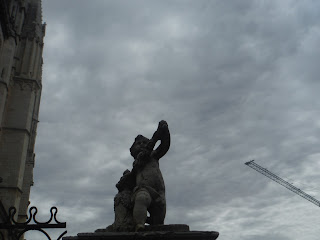



















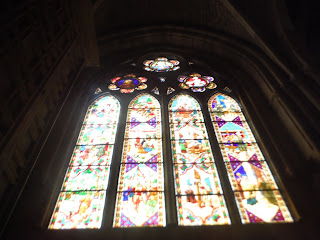









































































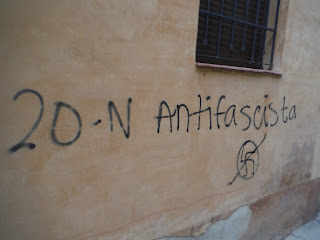






























































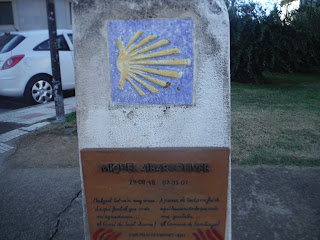


































































































































































































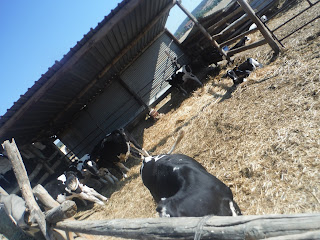
































































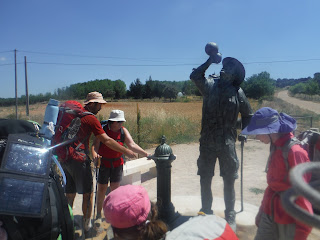









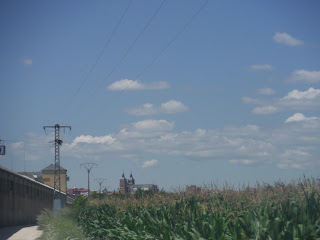




































































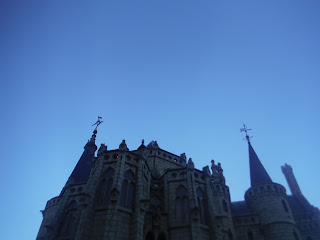

















































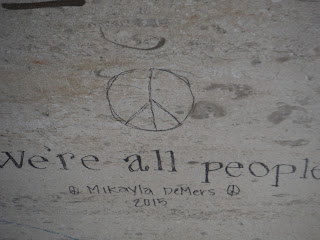

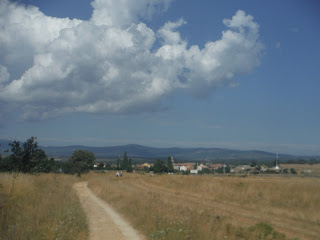



























































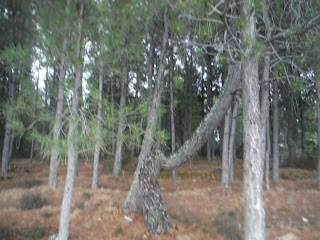





































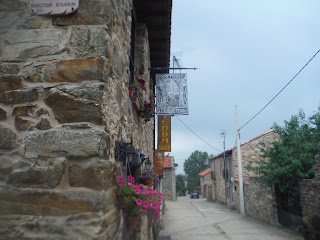




































































ReplyDeleteHerbal Treatment: Cure Herpes Virus Permanently. A Lasting Solution..Great service... robinsonbucler@Gmail com.……………………………….